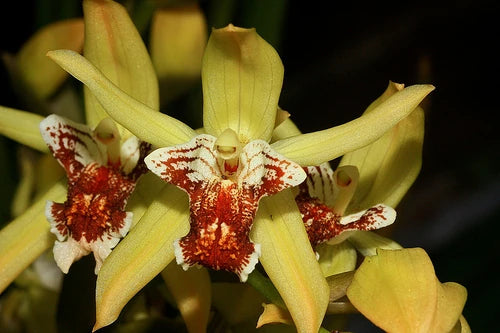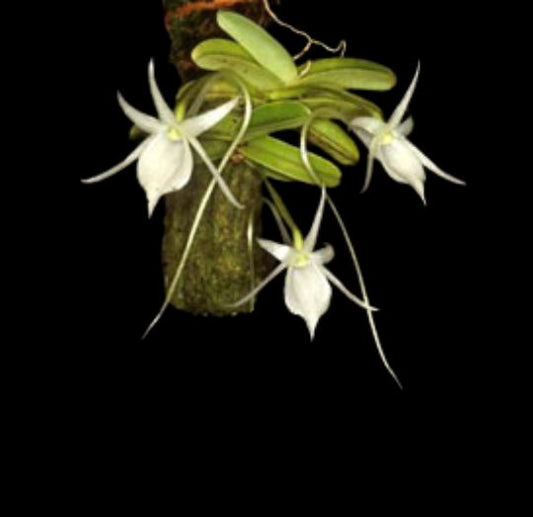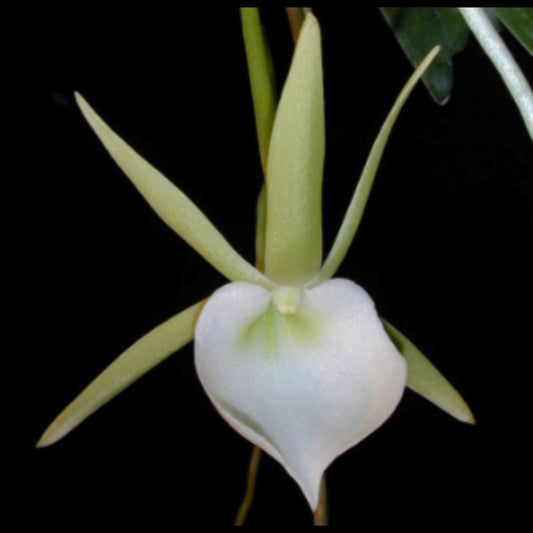La Foresta Orchids
Coelogyne asperata
Coelogyne asperata
No se pudo cargar la disponibilidad de retiro
Introducing the Exquisite Coelogyne asperata Orchid: A Tropical Beauty for Your Collection
Discover the mesmerizing allure of the Coelogyne asperata orchid, a captivating species found in the lush regions of Sulawesi, the Moluccas, Borneo, Java, Sumatra, the Philippines, Papua, New Guinea, Malaysia, and the Solomon Islands. This epiphytic or sometimes lithophytic orchid thrives in the enchanting ambiance of swamp forests near rivers and streams, flourishing at elevations ranging from sea-level up to 1600 meters.
Its majestic appearance leaves no room for disappointment. This large-sized orchid boasts striking features, including somewhat compressed, ribbed, and broadly conical pseudobulbs that grow up to 10-12 inches long. Graceful, long-petiolate, plicate leaves add to its elegance, making it a true showstopper in any collection.
Witness the magical transformation when late winter, spring, and summer arrive, as the Coelogyne asperata graces us with its blooming glory. Its terminal, arching inflorescence stretches up to 45 cm, adorned with ovate, large, dry, and concave floral bracts. Prepare to be enchanted by 15 to 40 fragrant, waxy flowers emerging from the apex of a new growth. The sepals and petals enchant with their pleasing deep cream or yellow hue, while the lip showcases the same base color, beautifully accentuated by a bright orange ridge, and adorned with reddish-brown or chocolate veins.
Cultivating Tips for a Flourishing Coelogyne asperata:
-
Light: Provide your Coelogyne asperata with a light level of 20000-30000 lux. Filtered or dispersed light is ideal, and avoid direct sunlight during the afternoon hours. Ensuring strong air movement around the orchid will contribute to its well-being.
-
Temperature: Throughout the year, maintain an average day temperature of 22-24 °C and an average night temperature of 13-15 °C, with daily variations of 7-11 °C. The slightly drier period in winter and early spring may bring about the hottest days and coldest nights, with a larger daily amplitude. To foster growth, consider placing the orchid close to a cold, humid air outlet if using a cooling air humidifier.
-
Humidity: Aim for a humidity level of 75-80% for most of the year, gradually decreasing to about 60-65% in late winter and early spring. In its natural habitat, slightly higher humidity may prevail. Be cautious about dry air, as it can hinder the plant's development, leading to yellowing and drying of leaves. Higher temperatures necessitate higher humidity levels, requiring more frequent and longer room ventilation to prevent rot and fungal diseases.
-
Substrate, Growing Media, and Repotting: Coelogyne asperata thrives when attached to tree fern or cork pieces, especially during hot and sunny summer days, which demand increased humidity and more frequent watering. Alternatively, shallow containers or baskets can be used, allowing the drooping racemes to gracefully hang over the sides. For a successful growth medium, consider a mix of chopped tree fern fibers, 10% perlite, 10% cut sphagnum moss, and 10% charcoal, which decomposes slowly and provides excellent results. If using fir bark, add humectants to prevent quick decomposition, as frequent repotting can negatively impact the orchid's flowering.
-
Watering: During the intensive growth periods, ensure abundant watering while preventing the substrate from becoming overly soaked. Limit watering during late autumn. Adequate watering depends on the content temperature, with higher temperatures requiring more frequent watering. Always ensure excess water flows freely from the pot to avoid root and plant base rot.
-
Fertilizer: During active growth, fertilize the Coelogyne asperata once a week with 1/4-1/2 of the recommended orchid fertilizer dose. Some growers prefer sustainable fertilizer throughout the year, while others opt for increased nitrogen content in spring to mid-summer and higher phosphorus content in late summer and autumn. Regularly rinse containers to avoid mineral deposit accumulation.
-
Rest Period: Maintain stable temperatures similar to the summer growing season throughout the year. In winter, reduce watering to a certain extent, especially in darker conditions typical of higher latitudes. Occasional fogging in the early morning will suffice during the rest period. Reduce or halt fertilization until new growths appear and spring watering resumes.
This is a XL blooming size in a 6" or 8” pot about 1 to 2 years to bloom, grown from seed, limited!
Bring the essence of tropical splendor into your space with the enchanting Coelogyne asperata orchid. With its stunning appearance and a touch of care based on these cultivating tips, this remarkable orchid will grace your collection and steal hearts with its captivating beauty.


























